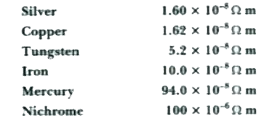(i) The potential difference between two points in an electric circuit is 1 volt. What does it mean? Name a device that helps to measure the potential difference across a conductor.
(ii) Why does the connecting cord of an electric heater not glow while the heating element does?
(iii) Electrical resistivities of some substances at 20∘C are given below:

Answer the following questions using above data:
(a) Among silver and copper, which one is a better conductor? Why?
(b) Which material would you advise to be used in electrical heating devices and why?
Text Solution
(i) The potential difference between two points is 1 volt means that if a charge of I coulomb is moved from one point to the other, 1 joule of work is required.
The potential difference across a conductor is measured by means of an instrument called the "voltmeter."
(i) The electric power P is given by
P=I2R
The resistance of the heating element is very high. Large amount of heat generates in the heating element and it glows hot.
The resistance of connecting cord is very low. Thus, negligible heat generates in connecting cord and it does not glow.
(iii) (a) Silver is a better conductor due to its lower resistivity
(b) Nichrome should be used in electrical heating devices due to very high resistivity.
|
Topper's Solved these Questions
- ELECTRICITYBook:VK GLOBAL PUBLICATIONChapter:ELECTRICITYExercise:NUMERICALS
Explore 2 Videos
- ELECTRICITYBook:VK GLOBAL PUBLICATIONChapter:ELECTRICITYExercise:NUMERICALS (RESISTANCE AND RESISTIVITY)
Explore 23 Videos
- ELECTRICITYBook:VK GLOBAL PUBLICATIONChapter:ELECTRICITYExercise:SHORT ANSWER QUESTION-II
Explore 8 Videos
- LIGHT-REFLECTION AND REFRACTIONBook:VK GLOBAL PUBLICATIONChapter:LIGHT-REFLECTION AND REFRACTIONExercise:PROFICIENCY EXERCISE (Long Answer Questions)
Explore 5 Videos
Similar Questions
Knowledge Check
Name a device that helps to maintain a potential difference across a conductor .
AElectric cellBVoltmeterCResistorDVariable Resistor
Why does the cord of an electric heater not glow while the heating element does ?
View SolutionName a device that helps to maintain a potential difference across a conductor.
View SolutionName a device that helps to maintain a potential difference across a conductor.
View SolutionName a device that helps to maintain a potential difference across a conductor.
View SolutionName a device that helps to maintain a potential difference across a conductor.
View SolutionWhy does the cord of an electric heater not glow while the heating element does ?
View SolutionWhy does the cord of an electric heater not glow while the heating element does ?
View Solution

